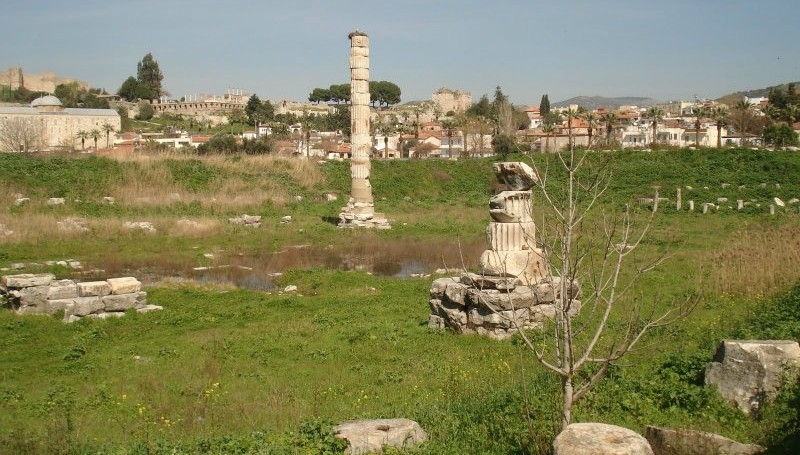The Temple of Artemis (Ephesus)
"Lo, apart from Olympus, the Sun never looked on aught so grand." These words of awe were spoken by Antipater of Sidon, who compiled the list of The Seven Wonders of the World, when he first set eyes on the Temple of Artemis at Ephesus. This temple was probably the fourth to be built on this sacred site, just outside Selcuk and about 3 km from the ruins of Ephesus.
Little is known about the first temple to have been discovered there other than it was of wood with a clay floor and was destroyed by a flood which left it under half a metre of silt. The building of the second temple, during the time that Ephesus was inhabited by Leleges and Lydians, was attributed by the historian Callimachus to the Amazons, who revered Artemis as their Mother Goddess. Artemis, twin sister of Apollo and daughter of Leto and Zeus, is usually depicted as having her torso covered with breasts or eggs. This temple was destroyed by raiding Cimmerians who came from the north of the Black Sea.
The third temple, built around 600 BC when Ephesus was beginning to be an important port, was designed by the architect Chersiphron but was short lived as it was destroyed during battles between the Lyddians and invaders from other cities.
The next, designed by Theodorus and partly financed by the legendary King Croesus, was four times the size of its predecessor and had walls of stone with a roof of wood. This was destroyed by Herostratus who, in seeking fame at any price, set fire to the roof, and was later executed for his crime. Legend has it that Artemis was unable to save her temple from the blaze because she was too busy in attendance at the birth of Alexander the Great.
Finally, the greatest temple of all was built and became one of the Wonders of the World. This remarkable edifice, believed to have been the first made from marble, was, with its 127 columns, 18 metres in height 137 metres long and 69 metres wide, twice the size of the Parthenon in Athens. It contained many works of including four bronze statues of Amazons who were said not only to be the builders of an earlier temple but also the founders of Ephesus itself. Alexander the Great had offered to fund the building when he visited the site but his offer was declined by the proud Ephesians because they did not want to have his name inscribed on it.
It is said that when St. John was preaching in the Temple and casting out demons, the altar split in two causing many terrified citizens to convert to Christianity. Later, St. Paul’s preaching caused riots inspired by the craftsmen who made and sold figurines of Artemis for their living and he was forced to flee the city.
The temple was severely damaged by marauding Goths in 268 AD when both the city and the worship of Artemis were already in decline. Its subsequent history is unclear. It may have been partially restored or its stones may simply have been salvaged and used elsewhere. Most of what remained was flattened in a series of severe earthquakes in 401 AD, by which time Emperor Constantine had made Christianity the official religion of his empire and so the temple was never rebuilt.
In 1869, after searching for six years, a team led by John Turtle Wood from the British Museum rediscovered the temple and took most of the remains to the museum in London where they can still be seen today. The only remnants still at the site are a single standing column and a few bases.

